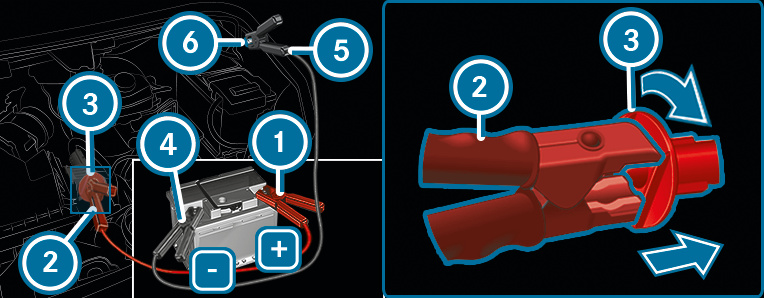When charging using a battery charger without a restriction of the maximum charging voltage, the battery or the on-board electronics can be damaged.
There is a danger of hydrogen gas igniting when charging the battery if there is a short circuit or sparks start to form.
During the charging process and starting assistance, the battery may release an explosive gas mixture.
A discharged battery may freeze at temperatures slightly above or below freezing point.
During starting assistance or battery charging, battery gas can be released.
If the warning/indicator lamps do not light up in the instrument display around or below freezing point, it is very likely that the discharged battery has frozen.
do not give the vehicle starting assistance or charge the battery
the service life of a battery that has been thawed may be reduced drastically
the starting behaviour may deteriorate, particularly at low temperatures
it is recommended that you have a thawed battery checked at a qualified specialist workshop
Numerous or extended attempts to start the engine may damage the catalytic converter due to non-combusted fuel.
only use undamaged jump leads/charging cables with a sufficient cross-section and insulated terminal clamps
non-insulated parts of the terminal clamps must not come into contact with other metal parts while the jump leads/charging cables are connected to the battery/jump-start connection point
the jump leads/charging cables must not come into contact with any parts which may move when the engine is running
make sure that neither you nor the battery is electrostatically charged
avoid fire and naked flames
do not lean over a battery
when charging: only use a battery charger that has been tested and approved by Mercedes-Benz and read the operating instructions for your charger before charging the batteries
starting assistance may only be provided using batteries with a nominal voltage of 12 V.
the vehicles must not touch each other
vehicles with a petrol engine: only perform starting assistance when the engine and exhaust system are cold
 .
. 
Right-hand drive vehicle: the jump-start connection may be on the opposite side.
 of the starting assistance/charging cable to the POSITIVE terminal of the donor battery.
of the starting assistance/charging cable to the POSITIVE terminal of the donor battery.  of the starting assistance/charging cable, slide the red protective cap on jump-start connection
of the starting assistance/charging cable, slide the red protective cap on jump-start connection  back with a clockwise turn.
back with a clockwise turn.  to the POSITIVE terminal of jump-start connection
to the POSITIVE terminal of jump-start connection  .
.  of the starting assistance/charging cable to the NEGATIVE terminal of the donor battery.
of the starting assistance/charging cable to the NEGATIVE terminal of the donor battery.  of the starting assistance/charging cable to earth point
of the starting assistance/charging cable to earth point  on your own vehicle (bare metal part in the engine compartment).
on your own vehicle (bare metal part in the engine compartment). When the starting assistance/charging process is complete:
 from earth point
from earth point  in the engine compartment, then black NEGATIVE terminal clamp
in the engine compartment, then black NEGATIVE terminal clamp  from the donor battery. Then remove second red POSITIVE terminal clamp
from the donor battery. Then remove second red POSITIVE terminal clamp  from the POSITIVE terminal of jump-start connection
from the POSITIVE terminal of jump-start connection  , followed by red POSITIVE terminal clamp
, followed by red POSITIVE terminal clamp  on the donor battery.
on the donor battery. The red protective cap springs back to its initial position when second red POSITIVE terminal clamp  is disconnected from jump-start connection
is disconnected from jump-start connection  .
.
You can obtain further information at a qualified specialist workshop.

